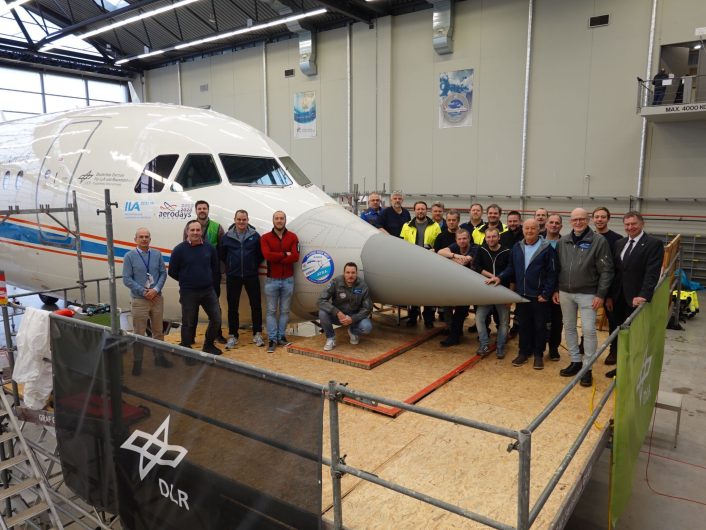The nose section was specifically designed and manufactured by a team of Airbus Defence and Space engineers to install the ECRS Mk.1 AESA radar on the A320 D-ATRA flying testbed.
In a significant step in the development of the ECRS (European Common Radar System) Mk.1 that will equip future Eurofighter Typhoons of Germany and Spain, Airbus has modified the A320 D-ATRA research aircraft of the German Aerospace Center (DLR). The company has manufactured a specially-designed radome, similar to the one of the Eurofighter, that will carry the radar and replace the A320’s original nose.
The pictures were posted on LinkedIn by Thomas Hirsch, the Vice-President and Program Manager of the ESCAN MK1 Integrated Project Team at Airbus Defence and Space. In an earlier post announcing the manufacturing of the nose section, Hirsch said that it was produced by Airbus Defence and Space in Manching and was on its way to Braunschweig. Both locations are in Germany, with the former being the main Airbus facility in the country and the latter being the base of the A320.
In the latest post, Hirsch added “The team of Airbus DS Manching, Airbus Toulouse and DLR Braunschweig is hard at work preparing the dedicated MK1 flying testbed to rigorously evaluate this cutting-edge technology in real-world conditions.”

Flying test beds and A320 D-ATRA
Hirsch mentioned that the nose section was “manufactured and ‘handcrafted’ by an incredible performant Team of Airbus Defence and Space on Manching site.” He described the D-ATRA as “the essential enabler Flying Testbed asset for the cutting-edge MK1 Eurofighter Combat AESA RADAR System for Germany and Spain.”
The nose section however does not seem to be an exact replica of the nose radome installed on the Typhoon aircraft, which is wider and with symmetrical curvatures on both the top and bottom. The A320 D-ATRA’s nose, on the contrary, looks thinner, with the slope on the top appearing more inclined.
DLR says that the A320 D-ATRA is the largest member of its research aircraft fleet and has been used by the DLR since 2008, for aviation technology including safety concepts, cabin comfort, aerodynamics, avionics, engines and airframe behaviour. In future, the ATRA (Advanced Technology Research Aircraft) will have several cockpit interfaces to test cockpit display systems, additional data links and a heads-up display. This can be used to develop flight control softwares, autonomous flight and pilot assistance.

Flying Test Beds (FTB) with modified nose radars and avionics of under-development projects are common: they provide a controlled, efficient, and cost-effective environment to validate and optimize new radars and sensors before committing to integration with the operational platform, ensuring reliability and performance while reducing risks and costs. A popular one is the Boeing 757 “Catfish” (registration N757A). This aircraft’s front section houses the F-22 radar, with an additional pair of small wings on top of the cockpit section. The B-757 N757A is easily identifiable and often spotted at Nellis AFB in Nevada and Edwards AFB in California.
Test beds are not used only for radars and sensors. India’s Kaveri engine, for an instance, was initially tested on an Ilyushin Il-76 FTB of the Gromov Flight Research Institute in Moscow. Teams of engineers are present inside the aircraft, monitoring any given system’s (in the A320’s case the ECRS MK1’s) structural behaviour and performance, gathering data that informs the development.
Earlier this month, Leonardo announced that the FTA (Flight Test Aircraft) ‘Excalibur’ for the sixth generation GCAP (Global Combat Air Programme), a modified Boeing 757, took its first flight. The former commercial airliner was overhauled with new side and belly pods designed to house the ISANKE & ICS (Integrated Sensing And Non Kinetic Effects & Integrated Communication System) that Leonardo UK and other partners are developing for the GCAP.
ESCAN radar takes to the skies in a Spanish #Eurofighter in a first test flight, conducted in close collaboration with the @EjercitoAire and @Defensagob.
Enhancing the Eurofighter’s capabilities in multimode air-to-air and air-to-ground operations, the electronically scanned… pic.twitter.com/3X224GzbyD
— Airbus Defence (@AirbusDefence) December 2, 2024
AESA Radar variants for the Typhoon
The Typhoons are poised to receive new AESA radars to replace the older Captor-M radars. Called European Common Radar System (ECRS) or the E-SCAN AESA radar, the new system has three variants: ECRS Mk.0, which currently equips the aircraft of Kuwait and Qatar; ECRS Mk.1, planned to equip the Typhoons from Germany and Spain; and ECRS Mk.2, which will also have an electronic warfare and electronic attack capacity, currently being developed for the United Kingdom.
The development also comes after a RAF (Royal Air Force) Typhoon FGR4 flew for the first time with the new Mk.2 AESA radar on Sep. 27, 2024 from BAE Systems’s Warton facility in the United Kingdom. Also, on Dec. 2, a Spanish Typhoon flew for the first time with the Mk.1 radar from Airbus’ Getafe facility in Spain.
The European Common Radar System (ECRS) MK-2 AESA radar developed by Leonardo is in the process of integration with the Royal Air Force Eurofighter typhoons. This advanced system shares some technologies being developed under Tempest project 🇬🇧 pic.twitter.com/nzy3DaBPNW
— Aero Cadre (@GDI_Aero) August 16, 2024
The ECRS Mk.1, jointly developed by Hesoldt and Leonardo, offers features like electronic warfare capabilities, including a multi-channel receiver, wider field of regard, improved target recognition, and an enhanced detection range. It is expected to enter service with the Luftwaffe’s Tranche 4 and 5 Eurofighters.
The Typhoon’s broader P4E SD (System Definition) package includes an automated sensor management capability for all Typhoon radars. The new features bring the rest of the avionics to technologically match the ECRS, and allow the radar itself to complete simultaneous tasks, while reducing pilot workload. P4E also includes the new Praetorian Defensive Aids Sub-System (DASS) and an upgraded Pirate Infra-Red Search and Track (IRST).









